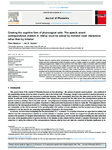Creating the cognitive form of phonological units: The speech sound correspondence problem in infancy could be solved by mirrored vocal interactions rather than by imitation
| dc.contributor.author | Messum, P | |
| dc.contributor.author | Howard, Ian | |
| dc.date.accessioned | 2016-01-01T00:55:20Z | |
| dc.date.available | 2016-01-01T00:55:20Z | |
| dc.date.issued | 2015-11 | |
| dc.identifier.issn | 0095-4470 | |
| dc.identifier.uri | http://hdl.handle.net/10026.1/4088 | |
| dc.description.abstract |
Theories about the cognitive nature of phonological units have been constrained by the assumption that young children solve the correspondence problem for speech sounds by imitation, whether by an auditory- or gesture-based matching to target process. Imitation on the part of the child implies that he makes a comparison within one of these domains, which is presumed to be the modality of the underlying representation of speech sounds. However, there is no evidence that the correspondence problem is solved in this way. Instead we argue that the child can solve it through the mirroring behaviour of his caregivers within imitative interactions and that this mechanism is more consistent with the developmental data. The underlying representation formed by mirroring is intrinsically perceptuo-motor. It is created by the association of a vocal action performed by the child and the reformulation of this into an L1 speech token that he hears in return. Our account of how production and perception develop incorporating this mechanism explains some longstanding problems in speech and reconciles data from psychology and neuroscience. | |
| dc.format.extent | 125-140 | |
| dc.language | en | |
| dc.language.iso | en | |
| dc.publisher | Elsevier BV | |
| dc.subject | Phonological units | |
| dc.subject | Underlying representation of speech | |
| dc.subject | Speech acquisition | |
| dc.subject | Correspondence problem | |
| dc.subject | Development of pronunciation | |
| dc.subject | Imitation | |
| dc.subject | Mirroring | |
| dc.title | Creating the cognitive form of phonological units: The speech sound correspondence problem in infancy could be solved by mirrored vocal interactions rather than by imitation | |
| dc.type | journal-article | |
| dc.type | Journal Article | |
| plymouth.author-url | https://www.webofscience.com/api/gateway?GWVersion=2&SrcApp=PARTNER_APP&SrcAuth=LinksAMR&KeyUT=WOS:000365378900011&DestLinkType=FullRecord&DestApp=ALL_WOS&UsrCustomerID=11bb513d99f797142bcfeffcc58ea008 | |
| plymouth.volume | 53 | |
| plymouth.publication-status | Published | |
| plymouth.journal | Journal of Phonetics | |
| dc.identifier.doi | 10.1016/j.wocn.2015.08.005 | |
| plymouth.organisational-group | /Plymouth | |
| plymouth.organisational-group | /Plymouth/Faculty of Science and Engineering | |
| plymouth.organisational-group | /Plymouth/Faculty of Science and Engineering/School of Engineering, Computing and Mathematics | |
| plymouth.organisational-group | /Plymouth/REF 2021 Researchers by UoA | |
| plymouth.organisational-group | /Plymouth/REF 2021 Researchers by UoA/UoA11 Computer Science and Informatics | |
| plymouth.organisational-group | /Plymouth/Users by role | |
| plymouth.organisational-group | /Plymouth/Users by role/Academics | |
| dc.rights.embargoperiod | No embargo | |
| rioxxterms.versionofrecord | 10.1016/j.wocn.2015.08.005 | |
| rioxxterms.licenseref.uri | http://www.rioxx.net/licenses/all-rights-reserved | |
| rioxxterms.type | Journal Article/Review |


